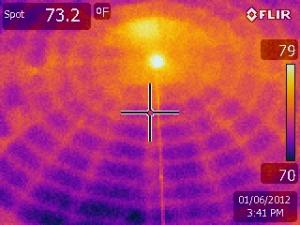One of the key components of an effective home energy audit is infrared thermography. Also called thermal imaging, it's the inspection of a home, including the basement, attic, and all the nooks and crannies, with an infrared camera.

IR cameras (we like FLIR) detect the infrared radiation emitted by all objects. Since the amount of infrared radiation increases with temperature, thermography lets us see temperature differences. In this picture of uninsulated basement pipes (left), the red and yellow pipes are radiating heat into the colder, blue surroundings. In a situation like this, infrared analysis confirms what we already know: pipes need to be insulated.

Infrared analysis also gives a "behind the walls" peek. In this infrared image of the dome at the Rockland Public Library (left), warmer wooden framing appears yellow, and colder, uninsulated wall cavities appear pink and purple. Infrared analysis takes the guess-work out of pinpointing the drafts and missing insulation, revealing the spots where your house is wasting energy (and money). Learn more about our project at the Rockland Public Library - where the dome is now insulated - here.
